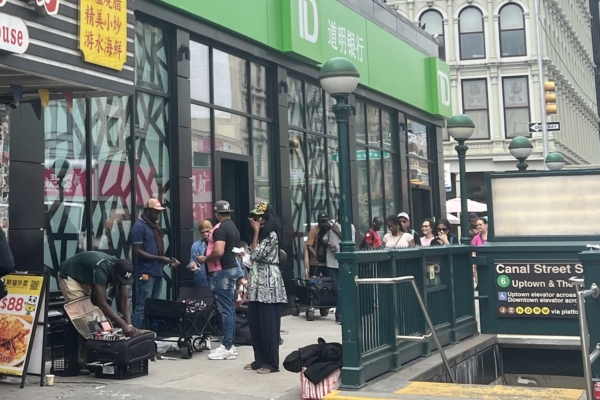After the epidemic, the number of street vendors in the community has been on the rise, becoming the new norm. In the bustling neighborhood of Chinatown on Canal Street, apart from the usual goods being sold, street vendors have started selling counterfeit designer products in broad daylight. According to reports, in the competition for customers, vendors have even resorted to physical confrontations. Recently, a Chinese woman got into a verbal dispute with an African immigrant selling fake goods. The altercation escalated, leading to the woman injuring the man and subsequently getting arrested.
According to police reports, the incident occurred on August 24th at 4:15 pm near a Chinese restaurant at 244 Canal Street. 29-year-old Weiting Lin, a Chinese woman, engaged in a verbal conflict with a 45-year-old male, and proceeded to spray pepper spray on his face, resulting in her arrest and a charge of assault in the second degree. The woman had a previous record of arrests.
Our reporter visited the scene yesterday and found that the incident took place near a subway station exit, which typically sees a high volume of pedestrian traffic. Despite the altercation, fake goods vendors were still operating in the area. However, there appeared to be a significant reduction in the counterfeit goods market along Canal Street.
“They will still come out in the future,” said Yu Jinshan, the chairperson of the New York East China Association, a senior immigration expert and author of books such as “The Complete Guide to US Immigration.”
Our reporter observed that apart from the subway entrance, some scattered fake goods vendors chose to place their merchandise near the entrance of gift shops, creating a sense of “coordination” with the legitimate items displayed. Some vendors who arrived later couldn’t find suitable spots like before, so they had to wait in a corner for the right opportunity.
Why is the market for counterfeit designer goods thriving? According to Yu Jinshan, the counterfeit goods market on Canal Street has a history of two to three decades, starting with Chinese immigrants selling goods on street stalls. Now, Chinese vendors have warehouses and display product catalogs on the street, taking customers to the warehouses to complete their purchases. In recent years, African immigrants, mainly from Senegal, joined in without warehouses, directly displaying goods in backpacks and suitcases on the street, sourced from the mainland.
Although this phenomenon seriously impacts luxury brand businesses, the main crackdown on counterfeits does not come from the police.
Yu Jinshan explained, “The crackdown on counterfeits is carried out by these companies that produce designer bags and clothing.” These luxury brands can take action under municipal orders to crack down on counterfeits, but face limitations in terms of manpower and enforcement capabilities.
He pointed out that the root cause lies in the lack of strict oversight at customs. Counterfeit goods enter in large quantities through container shipments at sea, and if there were rigorous inspections for a period of time, these markets could be “out of goods for half a year or a few months.”
Yu Jinshan stated that currently, the vendors of fake goods from different ethnicities usually coexist peacefully, but with new immigrants joining in to make a living on the streets, it may be challenging to maintain civility in the long run.

